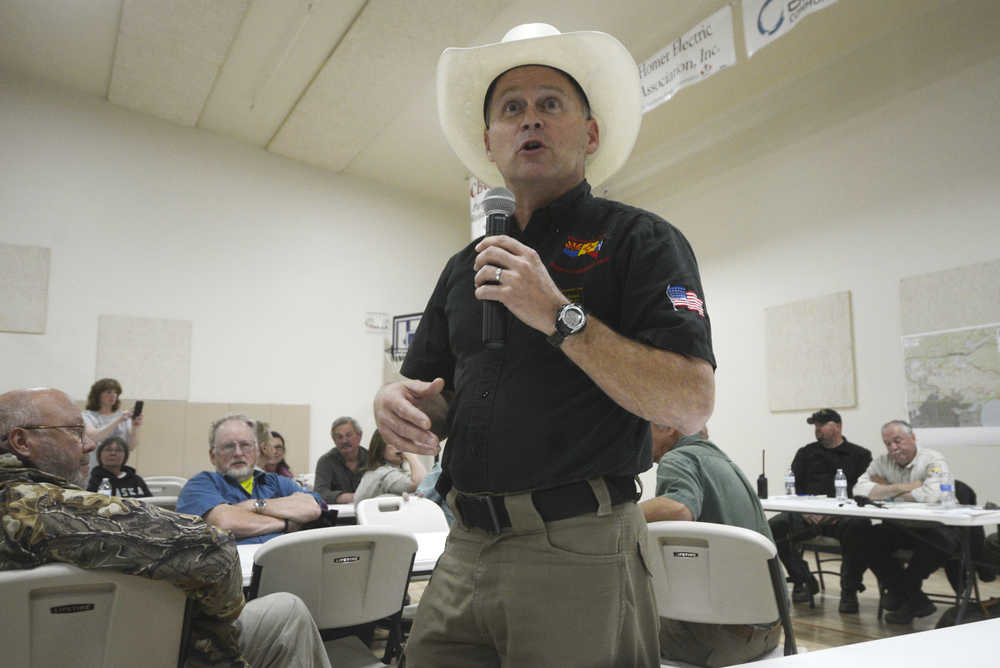As the humidity rises and the temperature drops, the Card Street wildfire is smoldering in place, according to representatives of responding agencies who spoke at an information session at the Sterling Community Center on Sunday.
“I really don’t think we had any fire growth yesterday, and I’m not sure we’re going to have any fire growth today,” said the response team’s incident commander Bob Allbee. The current size of the fire is 7,657 acres.
Stewart Turner, the command team’s fire behavior analyst, provided further detail. Cooler, more humid weather is adding moisture to the duff layer of the soil — the moss and organic matter covering the first few inches of the ground — material that “moves the fire around the most and stimulates the most growth,” Turner said.
However, the increased moisture of the duff layer is encouraging the fire to enter layers that remain dry from a lack of snowpack this winter and light rains in the spring.
“(The deeper soil layers) are not getting moisture in from the higher humidity,” Turner said. “So when fires do burn, they burn deeper and they hold down there longer. That’s the situation we’re facing now.”
Fire in deep soil layers could create a longer-term threat.
“When we bring those hot temperatures back and lower that humidity, we’ll probably see that fire start to move around again,” Turner said.
At present, Turner said people returning to burnt areas might observe some generally non-threatening “creep and smoulder.”
“At dark — or dusk, or twilight, or whatever you call that here — as the sun goes down a little bit, you’ll see some glows out there, some smouldering,” Turner said. “That’s going to happen a long time, until some firefighters get out there to extinguish that, or until the fuel is completely consumed. Then they’ll go out.”
Occasional flames might also be spotted.
Turner said in most cases, smouldering and small flare-ups are not cause for alarm. As for long-term solutions, Turner said that the best might be provided by the weather.
“What you’re all looking for is rain,” Turner said. “That’s what it’s going to take.”
Some questions from those returning to burn areas focused on practical and immediate concerns. Approximately 190 Enstar customers in the burnt areas of Kenai Keys and Feuding Lane are without heat or hot water since Enstar shut off its natural gas lines. In response to their questions, Enstar Southern Division Operations Manager Charlie Pierce said the gas line is currently pressurized with air that will have to be purged before it can resume function, a job that Pierce said Enstar crews will begin Monday, with the goal of having the gas back on by that afternoon.
Pierce said customers shouldn’t reactivate meters or reignite pilot lights themselves, but should instead wait until the line is reactivated, then call Enstar at 262-9334 to add their names to a service list. Alternatively, Enstar will have six trucks in the area with crews that will be able to reactivate meters.
In response to a question about how to clean up the red fire-retardant material that airplanes dumped on the fire, Alaska Division of Forestry fire manager Howie Kent said the material can be washed off of vehicles and structures with soap and water. He added that the retardant can be corrosive and should be washed from vehicles or other metal surfaces as soon as possible.
Kent said that the retardant — containing ammonia and clay — is not environmentally damaging, and that the ammonia can act as a fertilizer when it seeps into the ground. Kent said that a material safety data sheet on the retardant will be posted on the Kenai Peninsula Borough’s fire information blog at kpboem.blogspot.com.
Because the retardant contains ammonia, Division of Forestry Public Information Officer Terry Anderson said it has the potential to create chlorine gas in reaction to bleach. People should not attempt to wash the retardant with bleach, especially in a confined area.
Reach Ben Boettger at ben.boettger@peninsulaclarion.com.

